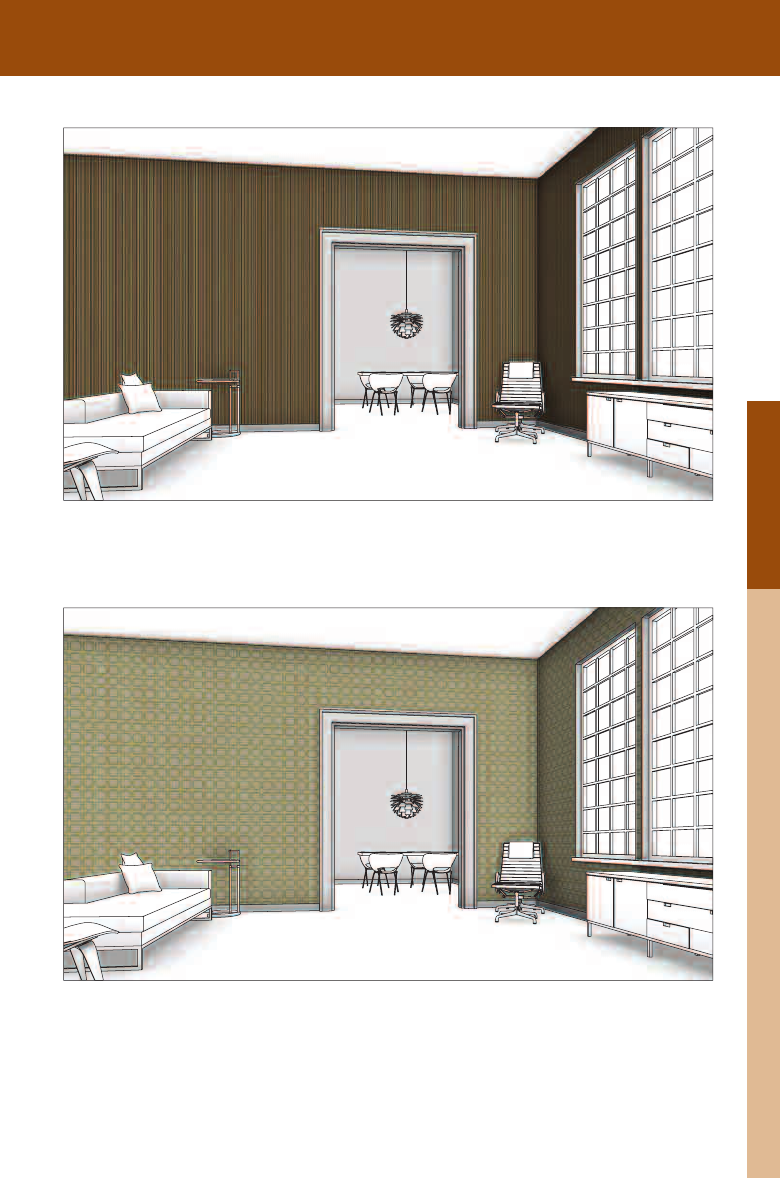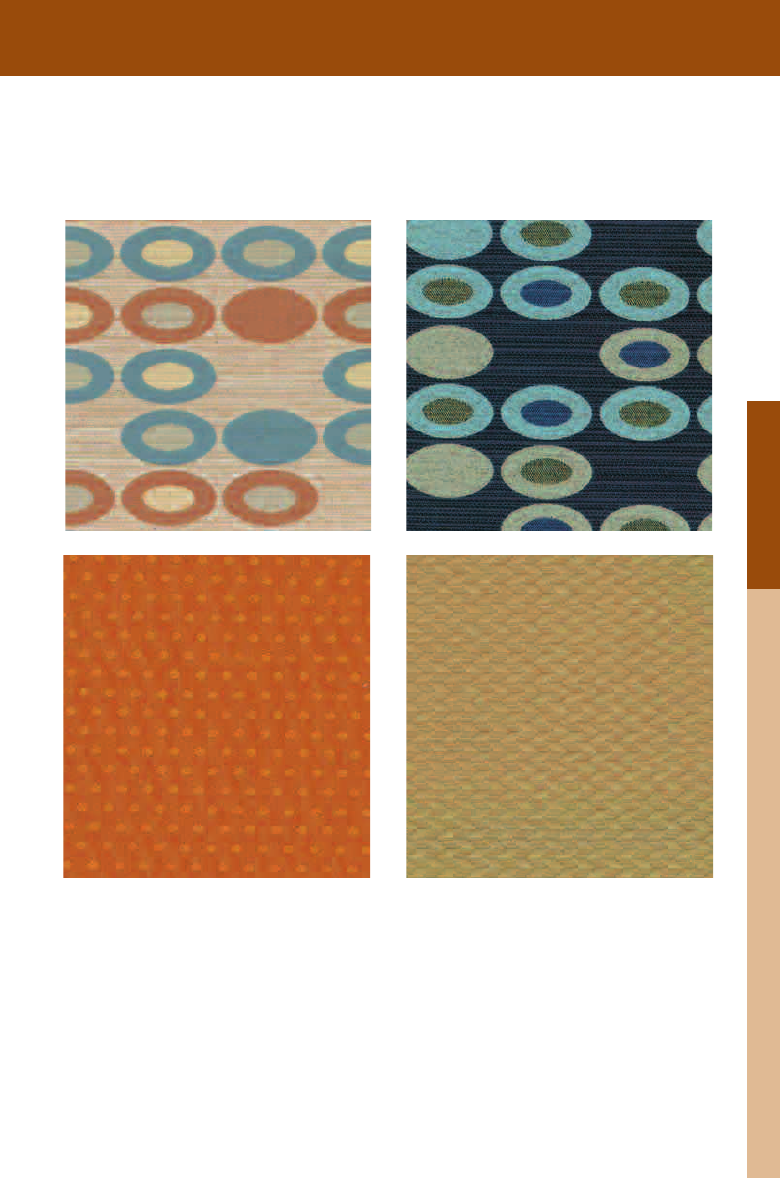
12
Job:02-30056 Title: RP-Interior Design Reference and Specification
#175 Dtp:216 Page:200
(RAY)
200-211_30056.indd 200 3/4/13 7:47 PM
20 0
THE INTERIOR DESIGN REFERENCE + SPECIFICATION BOOK
Text
Chapter 12: Pattern
A pattern is a repetition of elements, typically laid in a grid. Patterns give visual
interest to the surfaces of a room, whether in a textile, wall covering, or ooring.
Although they are commonly associated with textiles, patterns can also be found
in such textural elements as a brick wall. The repetitive elements create balance
and order across surfaces, pleasing the eye, and a skilled interior designer can use
patterns to establish a desired mood. Patterns can be employed in small quantities
to highlight special features in a room or can cover every surface to blend all the
elements together. Although there are no set rules for applying patterns, it is impor-
tant to understand the effects of patterned surfaces on an interior.
EFFECTS OF PATTERNS
Patterned surfaces can alter the proportional readings of a space. Large-scale repeats with
complex patterns and contrasting colors can be appealing in a large room but can overwhelm
a small one. Complex patterns are best left for fabrics or oor surfaces and should be care-
fully considered for wall coverings.
Patterns with vertical lines can add height to a room with low ceilings. Curtains with vertical
lines that extend from oor to ceiling will make a room look taller. Conversely, patterns with
horizontal lines can make a room or a piece of furniture look wider.
Pattern has an effect on the mood of a space. A oral pattern on a surface will create a much
different feeling than a geometric pattern on the same surface. Patterns are expressive of
style and sensibility and immediately set the tone for an interior environment.
Job:02-30056 Title: RP-Interior Design Reference and Specification
#175 Dtp:216 Page:200
(RAY)
200-211_30056.indd 200 3/4/13 7:48 PM

12
Job:02-30056 Title: RP-Interior Design Reference and Specification
#175 Dtp:216 Page:201
(RAY)
Job:02-30056 Title: RP-Interior Design Reference and Specification
#175 Dtp:216 Page:200
200-211_30056.indd 201 3/4/13 7:47 PM
201
Text
and order across surfaces, pleasing the eye, and a skilled interior designer can use
patterns to establish a desired mood. Patterns can be employed in small quantities
elements together. Although there are no set rules for applying patterns, it is impor
-
complex patterns and contrasting colors can be appealing in a large room but can overwhelm
Patterns with vertical lines can add height to a room with low ceilings. Curtains with vertical
lines that extend from oor to ceiling will make a room look taller. Conversely, patterns with
horizontal lines can make a room or a piece of furniture look wider.
Pattern has an effect on the mood of a space. A oral pattern on a surface will create a much
different feeling than a geometric pattern on the same surface. Patterns are expressive of
style and sensibility and immediately set the tone for an interior environment.
Job:02-30056 Title: RP-Interior Design Reference and Specification
#175 Dtp:216 Page:201
(RAY)
Job:02-30056 Title: RP-Interior Design Reference and Specification
#175 Dtp:216 Page:200
200-211_30056.indd 201 3/4/13 7:48 PM

12
Job:02-30056 Title: RP-Interior Design Reference and Specification
#175 Dtp:216 Page:202
(RAY)
200-211_30056.indd 202 3/4/13 7:47 PM
202
THE INTERIOR DESIGN REFERENCE + SPECIFICATION BOOK
Text
The scale of a pattern determines how complex or busy it will look on a surface. For instance,
a pattern with a small repeat may appear as a solid color from across the room and only be
discernible at a closer viewing.
Color plays a large role in pattern. The more contrasting colors in a pattern, the more dynamic
the pattern. If a pattern is made up of different tones of the same color, it may be quite
subtle.
Pattern can make a surface or piece of furniture more pronounced. Pattern can be used strate-
gically to drawn the eye to a particular focal point.
Job:02-30056 Title: RP-Interior Design Reference and Specification
#175 Dtp:216 Page:202
(RAY)
200-211_30056.indd 202 3/4/13 7:48 PM

12
Job:02-30056 Title: RP-Interior Design Reference and Specification
#175 Dtp:216 Page:203
Job:02-30056 Title: RP-Interior Design Reference and Specification
#175 Dtp:216 Page:202
(RAY)
200-211_30056.indd 203 3/4/13 7:47 PM
203
Pattern
Text
The scale of a pattern determines how complex or busy it will look on a surface. For instance,
Color plays a large role in pattern. The more contrasting colors in a pattern, the more dynamic
the pattern. If a pattern is made up of different tones of the same color, it may be quite
subtle.
Texture, too, plays a role in pattern making.
A weave on a monochromatic textile can
create a pattern that adds interest to an
otherwise plain fabric.
Pattern can make a surface or piece of furniture more pronounced. Pattern can be used strate-
Job:02-30056 Title: RP-Interior Design Reference and Specification
#175 Dtp:216 Page:203
Job:02-30056 Title: RP-Interior Design Reference and Specification
#175 Dtp:216 Page:202
(RAY)
200-211_30056.indd 203 3/4/13 7:48 PM

12
Job:02-30056 Title: RP-Interior Design Reference and Specification
#175 Dtp:216 Page:204
(RAY)
200-211_30056.indd 204 3/4/13 7:47 PM
20 4
THE INTERIOR DESIGN REFERENCE + SPECIFICATION BOOK
Text
CHARACTERISTICS OF PATTERN
The endless variations on patterns are impossible to quantify; however, most patterns share
certain characteristics. Patterns are made up of repeats, which is the element repeated
across the surface. At its simplest, the repeat is uniformly laid in a grid. To give variety to the
pattern, it can also be rotated or mirrored along an invisible axis.
Uniform Repeat
Patterns can also be categorized by the depth of the design. The repeat will be either a two-
dimensional gure that plays up the surface of the material or a three-dimensional gure that
gives it depth. Three-dimensional patterns are most effective across a at surface, such as a
oor or wall surface; they have less impact on a billowing or draped fabric.
Two-Dimensional Pattern Three-Dimensional Pattern
Custom Patterns
The designer can incorporate pat-
terns into the design of a space
in one of two ways: The most
obvious is to select and specify
a pre-made pattern such as a
textile, wallpaper, carpet, and
so forth. The other is to custom-
design a surface by laying out a
pattern that is implemented in
the installation of the material.
Rotated Repeat
Job:02-30056 Title: RP-Interior Design Reference and Specification
#175 Dtp:216 Page:204
(RAY)
200-211_30056.indd 204 3/4/13 7:48 PM
..................Content has been hidden....................
You can't read the all page of ebook, please click here login for view all page.
